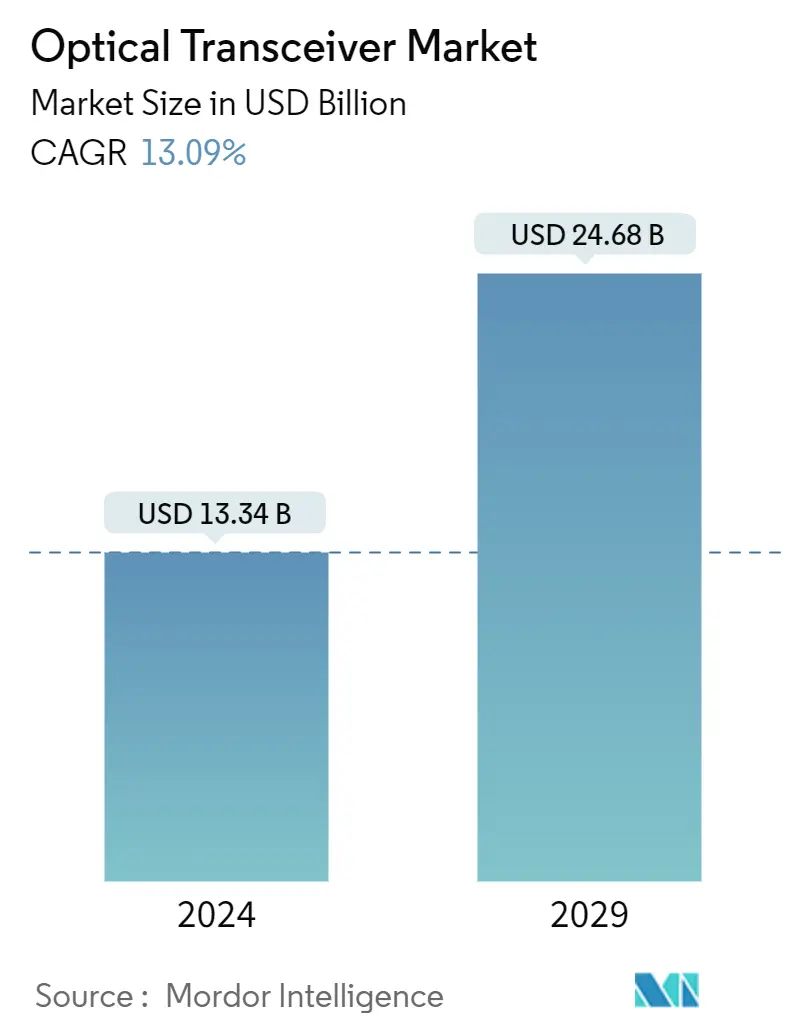Market Size of Optical Transceiver Industry

| Study Period | 2019-2029 |
| Market Size (2024) | USD 13.34 Billion |
| Market Size (2029) | USD 24.68 Billion |
| CAGR (2024 - 2029) | 13.09 % |
| Fastest Growing Market | Asia Pacific |
| Largest Market | North America |
Major Players
*Disclaimer: Major Players sorted in no particular order |
Need a report that reflects how COVID-19 has impacted this market and its growth?
Optical Transceiver Market Analysis
The Optical Transceiver Market size is estimated at USD 13.34 billion in 2024, and is expected to reach USD 24.68 billion by 2029, growing at a CAGR of 13.09% during the forecast period (2024-2029).
An optical transceiver, also known as a fiber optic transceiver, is an interconnect component used to transmit and receive data in a fiber-optic network. It consists of two main parts: a transmitter and a receiver. The transmitter converts electrical signals into light signals, which are transmitted through fiber optic cables. The receiver, on the other hand, receives light signals and converts them back into electrical signals.
- Optical transceivers enable high-speed data transmission over long distances. They can support high bandwidth applications like video streaming, cloud computing, and data centers. They can transmit data over long distances without significant signal degradation. They are commonly used in telecommunications and networking applications that require data transmission over kilometers of fiber optic cables.
- Due to several factors, the telecom industry is experiencing an increasing need for advanced communication. These factors include the demand for energy efficiency, the focus on delivering advanced connectivity, and the rise of new technologies such as the Internet of Things (IoT) and artificial intelligence (AI). Telecom companies strive to deliver advanced connectivity and higher performance to their customers. This includes deploying technologies like 5G, edge computing, and improved network infrastructure. These advancements enable faster and more reliable communication services. The advanced development and upgrade of the bearer network is anticipated to drive the demand for optical communication network equipment to increase as 5G technology progresses and base stations are deployed.
- Cloud-based services have experienced a significant increase in demand in recent years. Cloud computing allows businesses to reduce their IT infrastructure costs by eliminating the need for on-premises servers and hardware. Instead, companies can access computing resources and services on demand, paying only for what they use. Cloud services also offer the ability to scale resources up or down based on demand. The increasing adoption of cloud services owing to their significant advantages would create massive demand for advanced communication infrastructure, thereby driving the optical transceivers market.
- Optical transceivers, such as data centers, are critical in high-capacity data transmission networks. In recent years, there has been an increase in network complexity in optical transceivers. The demand for high data rates in modern networks has led to the development of optical transceivers capable of transmitting data at speeds ranging from 1G to 400 G. The higher data rates require more sophisticated designs and technologies to ensure reliable and efficient data transmission.
- The outbreak of COVID-19 increased the usage of data. According to a report on the impact of the COVID-19 pandemic on China's entertainment industry by Maoyan Entertainment, a leading platform providing innovative Internet-empowered entertainment services in China, the movie industry was severely hit by the pandemic, whereas the online entertainment market, including TV and streaming platforms, were booming as people were confined to their homes. This has led to the growth of the market.
